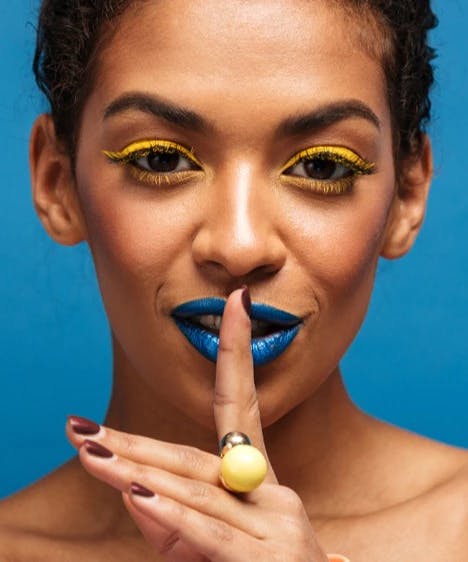Beauty's Dirty Open Secret: Toxic Makeup Is Making Women Sick
From the time we wake to the time we go to bed, beauty products make a way into our lives.

We go about our daily routine using products that we've used for years without a thought, and we purchase those items under the assumption that the ingredients are safe. But this may not be the case.
For the last two years, I've suffered from chronic migraines. Recently my neurologist performed an MRI and found white matter on my brain. I asked him what caused this. One of the reasons was simple: I was getting older. His other explanation? I could have been exposed to toxins at a job I had in the past...or my makeup.
My Makeup Was Causing My Migraines?
"My makeup?!" I asked. He stated that scientists are starting to link certain common ingredients found in skincare and makeup to a myriad of health problems. These can range from breast cancer, skin cancer, infertility, and last but not least, migraines. I left the office baffled. My makeup could be toxic? In general, I'm conscious of harmful chemicals. I make an effort to cut them out where I can at home. I try to eat well by avoiding processed foods and prepackaged meals. I would go as far as to say that I am a savvy consumer.
Scientists are starting to link certain common ingredients found in our skincare and makeup to a myriad of health problems.
When it came to my makeup and skincare, I was only aware of a handful of ingredients that we should try to avoid. (One is black hair dye, and the other is skin bleaching creams that use Hydroquinone.) When I got home from the appointment, I dove down the infinite rabbit hole that is the Internet. What I found was a bit disconcerting and a little overwhelming. Article after article warned me of toxic ingredients and why to avoid them. The term "clean beauty" was a common thread in all these articles.
What Is Clean Beauty?
Clean beauty is described as products that are produced without any proven or suspected toxic ingredients. Clean Beauty brands have a long list of potentially known toxins that their products don't contain. Some of the most common on these lists are oxybenzone, parabens, retinyl palmitate, retinyl acetate, retinoic acid, retinol, and polyethylene/PEG. Let's break these down into what they are and where we find them.
Oxybenzone: An organic chemical used in commercial plastics and makeup products.
Retinyl palmitate, retinyl acetate, retinoic acid, and retinol: The chemical compound derivative of vitamin A which is used in many anti-aging products such as night creams and topical wrinkle serums. These compounds are linked to skin cancer because they make the skin more sensitive to UV rays. (Instead, you can use products like immortelle oil, or beta-carotene enriched products to get the same benefits without the worry.)
Polyethylene/PEGs: The most common plastic used. It can be found in things like toys, plastic shopping bags, and food storage containers. PEGs are also in the exfoliator beads in our body wash/scrub and facial scrubs, and can even be found in toothpaste. They are used as a stabilizer in many skincare items. PEGs have been linked to leukemia, brain tumors, breast cancer, bladder cancer, and Hodgkin’s disease. Additionally, PEGS are harmful to the environment. The list of products containing PEGs is quite daunting - it makes up more than half of all the items we use in our daily lives.
Some Ways To Eliminate PEGS
Use glass instead of plastic for food storage, opt for paper or your own bag while shopping, and bring your own mug to the coffee shop. Have fun making your own body, face, or lip scrubs using items like olive oil, sugar, and kosher sea salt.
What Does the FDA Have To Say about It?
From the FDA website: "The law does not require cosmetic products and ingredients (except for color additives not intended as coal-tar hair dyes) to have FDA approval before they go on the market, but it does require them to be safe when consumers use them according to their labeling, or as they are customarily used. Also, any color additives used in cosmetics must be approved by the FDA."
I'm concerned about the FDA's regulations. They seem to be lax and potentially putting people at risk for serious health issues. I do think they should be a little more firm about the ingredients that consumers like you and I are using in up to 80% of our daily routine. If it's a known carcinogen, it should be banned from products outright. However, I also understand that it's our responsibility to be our own voice and to make educated decisions about what we allow in our homes and what products we put in or on our bodies.
I personally never thought to read my makeup labels like I would a new medication. Most of us don't sit around and think, “Is the SPF in my foundation causing my endometriosis”?
Most of us don't sit around and think, “Is the SPF in my foundation causing my endometriosis”?
The good news is, we have companies like Sephora that launched the "Clean at Sephora" campaign in June 2018. Sephora listened to their consumers and saw the need for alternative beauty products. If you shop online, you will see brands featuring the green "Clean at Sephora" tag. You can find over fifty brands that offer all of your beauty needs and wants.
Closing Thoughts
Not only was this research eye-opening, but it has also made me hyper-aware of paying attention to the products I may be using that have known side effects or are potentially harmful to me or my family.